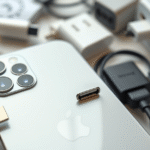Performance upgrades are at the forefront of speculation surrounding the upcoming M5 MacBook Pro, generating excitement among tech enthusiasts and professionals alike.
This article delves into the rumored enhancements that promise to elevate the MacBook Pro experience, including a substantial performance boost of 15% to 25% over the previous M4 chip.
We will explore the implications of these improvements on efficiency, particularly in AI and machine learning tasks, and examine the potential introduction of cutting-edge features like Wi-Fi 7 support and an OLED display.
Join us as we unpack what to expect from this anticipated release later this year.
Rumor Roundup Overview – Performance Upgrades
Apple enthusiasts are bracing for what could be one of the most exciting MacBook refreshes in recent years as rumors surrounding the M5 MacBook Pro continue to build momentum.
Expected later this year, the M5 chip is positioned as a significant leap in performance, boasting improvements estimated between 15% to 25% over the M4, offering not just speed, but enhanced efficiency and powerful AI and machine learning capabilities.
Beyond performance, speculation suggests a potential switch to OLED display technology, which would deliver deeper contrast, vibrant colors, and better power management, replacing the current miniLED system.
Connectivity also sees a boost as whispers point to the inclusion of Wi-Fi 7 support for ultra-fast wireless speeds.
These enhancements signal that Apple aims not just to update its laptop but to future-proof it for creative, technical, and mobile users alike.
For those tracking every development, detailed MacBook leak coverage has been instrumental in piecing together what to expect from this power-packed device.
Key Technological Upgrades – Performance Upgrades
Technological advancements play a crucial role in enhancing device performance and user experience.
Key upgrades can provide significant improvements in speed, efficiency, and functionality.
As new features are introduced, they reshape the landscape of computing, paving the way for innovative applications and better overall usability.
M5 Chip Performance Gains – Performance Upgrades
The rumored 15%–25% performance boost from Apple’s upcoming M5 chip marks a considerable leap over its predecessor, shaping the next-gen MacBook Pro into a powerhouse for demanding users.
Fueled by more GPU cores and an upgraded Neural Engine, the M5 is fine-tuned to handle neural tasks and machine learning operations with even greater speed and efficiency.
Compared to the already capable M4 chip, the M5 is expected to offer faster processing for advanced computational models, leading to smoother multitasking and lower power consumption during machine learning inference execution.
Additionally, the enhanced AI capabilities will empower creators and developers in particularly intensive workflows such as:
- Real-time video editing with background object removal
- AI-assisted photo enhancement and scene reconstruction
- On-device voice transcription and language processing
These improvements underscore Apple’s growing focus on AI-driven computing, aligning the MacBook Pro with evolving creative and productivity demands.
The advantages aren’t merely theoretical—developers leveraging local AI models will see tangible gains, unlocking real-time interaction and responsiveness previously dependent on cloud solutions.
Mark Gurman, Bloomberg (2023)
Display: OLED Emergence
The transition from MiniLED to OLED in the rumored M5 MacBook Pro reflects a pursuit of superior visual performance.
OLED panels introduce major improvements in contrast and color accuracy, as each pixel emits its own light, allowing true blacks and brighter highlights.
While MiniLEDs excel in peak brightness, they struggle with haloing artifacts due to backlight zones, which compromises uniform blacks.
OLED, by contrast, eliminates this concern entirely by disabling individual pixels when reproducing black.
As content creators and professionals demand more precise color grading and dynamic range, OLED becomes the logical successor.
To better illustrate the differences, here is a simplified side-by-side comparison.
| Feature | OLED vs MiniLED |
|---|---|
| Contrast Ratio | Higher / Lower |
| Color Accuracy | Superior / Good |
| Black Levels | True Black / Greyish Black |
According to Tom’s Guide MacBook Pro M5 overview, OLED integration would set a new standard for Apple’s displays, positioning the device at the forefront of creative workflows.
Next-Gen Connectivity
The rumored integration of Wi-Fi 7 in the upcoming M5 MacBook Pro represents a major leap in wireless connectivity, designed to amplify productivity and streamline professional workflows.
Unlike its predecessor, Wi-Fi 6E, this next-generation standard delivers lower latency and supports multi-gigabit throughput, which means faster file transfers, smoother cloud-based collaboration, and superior video conferencing quality even on congested networks.
This kind of speed and responsiveness is especially useful for creative professionals handling large media files or developers syncing massive repositories.
Because Wi-Fi 7 also supports multiple bands more intelligently, it ensures a more stable connection, which greatly benefits tasks like streaming 4K+ assets or operating on shared enterprise platforms.
As Apple considers this upgrade for the new MacBook Pros, users can expect not just better speed, but smarter, more efficient wireless performance across all tasks.
According to a report from Macworld, Apple may include Wi-Fi 7 in the M5 MacBook Pro lineup, offering superior connectivity for power users.
Launch Timing and Competitive Impact
Speculation surrounding the 2023 launch of the M5 MacBook Pro continues to intensify industry conversations, especially as Apple seems poised to accelerate innovation yet again.
A potential fall release could strategically position Apple just ahead of the holiday buying season, leveraging its market presence to outpace rivals relying on more incremental upgrades.
As performance gains for the M5 chip are expected to reach up to 25% over the M4, expectations around its efficiency and AI capabilities will likely redefine consumer expectations across premium laptops.
This shift puts added pressure on competitors like Dell and HP, who may struggle to deliver comparable performance without similarly integrated silicon architectures.
According to a Macworld analysis on the MacBook Pro M5 timeline, Apple’s refresh cycle could reshape Q4 buyer decisions significantly.
The market positioning advantage becomes even more pronounced when combined with possible Wi-Fi 7 integration and OLED display technology, giving Apple a decisive edge in technical appeal and user experience.
In conclusion, the M5 MacBook Pro is shaping up to be a significant leap forward in performance and features, setting the stage for an impressive lineup from Apple.
Stay tuned for its anticipated release in 2023 as we look forward to these exciting advancements.




